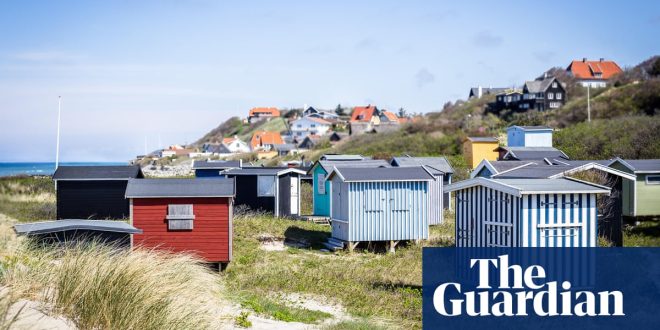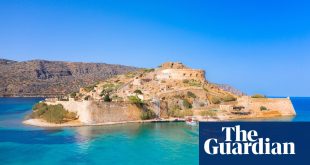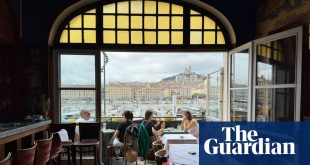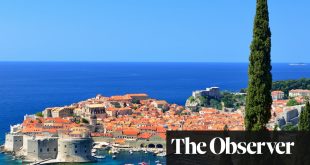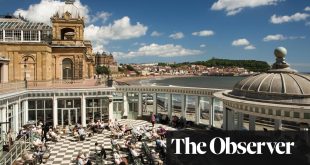I’m a mid-life cliche. I bought a campervan (Margo) and a dog (Maggie May) in lockdown. I dream of a life in Scandinavia – of forests, fika and foraging. I swim in the cold sea. But however cliched, the campervan has allowed my partner, me and the dog to go on adventures we couldn’t afford otherwise. We’ve roamed the Lake District, and camped on the Welsh coast. Last year, we hit the continent.
We meant to do it in 2022, aiming for northern Spain, but wildfires meant a last-minute pivot to Wales (which was wonderful but didn’t scratch the “abroad” itch). So last June we tried again, but instead of heading to the sunbaked south we turned east from Calais towards Denmark and southern Sweden. We had just over two weeks, aiming for Malmö.
The drive to Denmark is simple: east through Belgium and the Netherlands to Bremen in Germany, and then due north. It was tempting to dawdle in the pretty landscapes, but with 700 miles to drive, we pushed through, cheering as we crossed border after frictionless border.
The idea was to stick to the Danish coastline where we could, steering clear of cities, swimming as much as possible on the way. With everything we needed in Margo, we’d done minimal planning, and had no problems booking campsites a night ahead – or not at all.
After the German autobahn, our first stop in Denmark was at well-organised fjordside Sandskaer Strandcamping, near the small town of Aabenraa and surrounded by gentle, forested hills. A coastal hiking trail, the Gendarmstien, weaves along the Denmark-Germany border and takes in the Flensburg fjord.
We quickly learned how much the Danes love a campsite. We parked next to row upon row of deluxe caravans complete with little garden fences, outdoor kitchens and even washing machines. Everyone greeted us with a cheerful hej, before switching automatically into perfect English. Some Danish teenagers camping opposite us played death metal at a comedically low level until the dot of 9pm, when they turned it off voluntarily. Ordering the next morning’s fresh pastries (ready to be picked up for breakfast) quickly became my favourite part of the Danish campsite check-in ritual.
The large island of Funen, birthplace of Hans Christian Andersen, was our next stop, with its gothic castles, Viking burial grounds and pastel cottages. Faaborg Camping, on the edge of the tiny harbour town of Faaborg, was our base for exploring the south coast: there are ferries to the forested archipelago to the south, where Danes spend off-grid summers, but Faaborg’s municipal swimming pier complex was the main pull for us. Despite being next to the harbour, this giant wooden ramp offers swimmers easy access to crystal-clear water.
It was June and the sun shone for the entire holiday. All over Denmark in hot, dusty campsites, the ground was rock-hard and cracked. It was incredible, and incredibly worrying. With no aircon, we sought shade in forests and picnicked in glades by inland lakes, taking dips to cool off.
From here we headed east for Nyborg, where we crossed to the larger island of Zealand on the sixth-longest suspension bridge in the world (Zealand’s most easterly point is Copenhagen). Our goal was Roskilde, an ancient Viking port at the end of a fjord. The city’s main campsite, Roskilde Camping, is a pine-dotted parkland overlooking the fjord, with a beach and shallow waters that attract the town’s teenagers after school.
For little more than £20 a night, we pitched on a small hill, in the shade of the trees with views of the water. It was a minute’s walk to the sea and the campsite had a pizzeria, bar and cafe. Here, as at every campsite, water was rationed. A pre-loaded card allowed for daily three-minute showers and we had to top it up to do laundry.
Heading north again, we trundled through a fairytale-like landscape, a cross between East Anglia, with timber cottages painted Suffolk pinks, and a Disney cartoon, with tiny red-barned farms and perfect horses. Tisvilde, on the north-west coast, seemed like the Danish equivalent of Martha’s Vineyard, complete with fancy homeware stores selling beige linen clothes, artisan ice-creams and a vast, flat, windswept sandy beach, Tisvildeleje Strand, backed by dunes.
We crossed to Sweden on the ferry at Kronborg, an hour north of Copenhagen, arriving in Helsingborg 40 minutes later. It was an easy drive-up, catch-the-next crossing affair.
after newsletter promotion
South-west Sweden felt similar but slightly shifted. The farms were bigger, the roads wider. In Borstahusen, a formerly out-of-the-way fishing village now popular with second-homers, the lanes are lined with one-storey cottages.
The harbour’s fish restaurants are upmarket but refreshingly affordable, and after dinner we strolled back to another shoreside campsite, Mötesplats Borstahusen, full of food, the sky still not dark at 11pm.
Our last stop was Malmö. After 12 days of blazing sunshine, we parked the van and retreated into a hotel, the trendy MJ’s. Having worried that Scandinavia would bankrupt us, we found that everything here costs less than it does in the UK, so we could hit up the city’s best cocktail bar, handily in our hotel.
Malmö is a “20-minute city” that prioritises pedestrians and bikes, and its central medieval cobbled squares are ringed by a canal. Its famous castle and park, Slottsparken, is dotted with traditional windmills. I geeked out in the park’s herbal kitchen gardens before having to seek shade. It was getting hotter. We burned in the afternoon sun on a self-drive canal boat tour; it was too hot to even eat the sticky fika cinnamon buns we had been dreaming about. I revelled in the dark, cool hotel bathroom.
Our final destination was the Ribersborg’s Kallbadhus, a late 19th-century seaside sauna that looks like a set in a Wes Anderson film, with its long pier and sage green facade. For a few quid and no booking needed, I entered the world of the same-sex, fully naked Swedish sauna.
I went back and forth between dips in the sea and sweating in the sauna – with its windows over the water – and sunning myself on the wooden decking. The sky was cobalt and there was no wind – it was like the world had flattened to 2D.
It was hard to turn the van round and point it back west. Despite a steady diet of hotdogs and cinnamon buns and the oppressive heat, we felt happier and healthier. We went over the famous Øresund bridge, skimmed round Copenhagen and drove on to a ferry headed for the German coast and home.
LeShuttle operates crossings from Folkstone to Calais. For more information see visitsweden.com
 Top Naija News – Nigeria News, Nigerian News & Top Stories Top Naija News – Nigerian Newspapers, Nigerian News. topnaijanews is a daily Nigerian newspaper covering Latest News, Breaking News, Entertainment, Sports, Lifestyle and Politics.
Top Naija News – Nigeria News, Nigerian News & Top Stories Top Naija News – Nigerian Newspapers, Nigerian News. topnaijanews is a daily Nigerian newspaper covering Latest News, Breaking News, Entertainment, Sports, Lifestyle and Politics.
